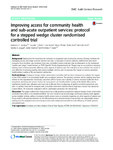Improving access for community health and sub-acute outpatient services: protocol for a stepped wedge cluster randomised controlled trial
| dc.contributor.author | Harding, KE | |
| dc.contributor.author | Watts, JJ | |
| dc.contributor.author | Karimi, L | |
| dc.contributor.author | O’Reilly, M | |
| dc.contributor.author | Kent, B | |
| dc.contributor.author | Kotis, M | |
| dc.contributor.author | Leggat, SG | |
| dc.contributor.author | Kearney, J | |
| dc.contributor.author | Taylor, NF | |
| dc.date.accessioned | 2016-12-16T18:08:39Z | |
| dc.date.available | 2016-12-16T18:08:39Z | |
| dc.date.issued | 2016-12 | |
| dc.identifier.issn | 1472-6963 | |
| dc.identifier.issn | 1472-6963 | |
| dc.identifier.other | 364 | |
| dc.identifier.uri | http://hdl.handle.net/10026.1/8131 | |
| dc.description.abstract |
BACKGROUND: Waiting lists for treatment are common in outpatient and community services, Existing methods for managing access and triage to these services can lead to inequities in service delivery, inefficiencies and divert resources from frontline care. Evidence from two controlled studies indicates that an alternative to the traditional "waitlist and triage" model known as STAT (Specific Timely Appointments for Triage) may be successful in reducing waiting times without adversely affecting other aspects of patient care. This trial aims to test whether the model is cost effective in reducing waiting time across multiple services, and to measure the impact on service provision, health-related quality of life and patient satisfaction. METHODS/DESIGN: A stepped wedge cluster randomised controlled trial has been designed to evaluate the impact of the STAT model in 8 community health and outpatient services. The primary outcome will be waiting time from referral to first appointment. Secondary outcomes will be nature and quantity of service received (collected from all patients attending the service during the study period and health-related quality of life (AQOL-8D), patient satisfaction, health care utilisation and cost data (collected from a subgroup of patients at initial assessment and after 12 weeks). Data will be analysed with a multiple multi-level random-effects regression model that allows for cluster effects. An economic evaluation will be undertaken alongside the clinical trial. DISCUSSION: This paper outlines the study protocol for a fully powered prospective stepped wedge cluster randomised controlled trial (SWCRCT) to establish whether the STAT model of access and triage can reduce waiting times applied across multiple settings, without increasing health service costs or adversely impacting on other aspects of patient care. If successful, it will provide evidence for the effectiveness of a practical model of access that can substantially reduce waiting time for outpatient and community services with subsequent benefits for both efficiency of health systems and patient care. TRIAL REGISTRATION: Australian and New Zealand Clinical Trials Registry ACTRN12615001016527 . Approved 15/9/2015. | |
| dc.format.extent | 364- | |
| dc.format.medium | Electronic | |
| dc.language | en | |
| dc.language.iso | en | |
| dc.publisher | Springer Science and Business Media LLC | |
| dc.subject | Ambulatory Care | |
| dc.subject | Appointments and Schedules | |
| dc.subject | Australia | |
| dc.subject | Community Health Services | |
| dc.subject | Cost-Benefit Analysis | |
| dc.subject | Health Services Accessibility | |
| dc.subject | Humans | |
| dc.subject | Models, Organizational | |
| dc.subject | New Zealand | |
| dc.subject | Patient Satisfaction | |
| dc.subject | Prospective Studies | |
| dc.subject | Quality Improvement | |
| dc.subject | Referral and Consultation | |
| dc.subject | Triage | |
| dc.subject | Waiting Lists | |
| dc.title | Improving access for community health and sub-acute outpatient services: protocol for a stepped wedge cluster randomised controlled trial | |
| dc.type | journal-article | |
| dc.type | Article | |
| plymouth.author-url | https://www.ncbi.nlm.nih.gov/pubmed/27506923 | |
| plymouth.issue | 1 | |
| plymouth.volume | 16 | |
| plymouth.publication-status | Published | |
| plymouth.journal | BMC Health Services Research | |
| dc.identifier.doi | 10.1186/s12913-016-1611-3 | |
| plymouth.organisational-group | /Plymouth | |
| plymouth.organisational-group | /Plymouth/Faculty of Health | |
| plymouth.organisational-group | /Plymouth/Faculty of Health/School of Nursing and Midwifery | |
| plymouth.organisational-group | /Plymouth/REF 2021 Researchers by UoA | |
| plymouth.organisational-group | /Plymouth/REF 2021 Researchers by UoA/UoA03 Allied Health Professions, Dentistry, Nursing and Pharmacy | |
| plymouth.organisational-group | /Plymouth/Research Groups | |
| plymouth.organisational-group | /Plymouth/Research Groups/Institute of Health and Community | |
| plymouth.organisational-group | /Plymouth/Research Groups/Plymouth Institute of Health and Care Research (PIHR) | |
| plymouth.organisational-group | /Plymouth/Users by role | |
| plymouth.organisational-group | /Plymouth/Users by role/Academics | |
| dc.publisher.place | England | |
| dcterms.dateAccepted | 2016-07-30 | |
| dc.identifier.eissn | 1472-6963 | |
| dc.rights.embargoperiod | No embargo | |
| rioxxterms.versionofrecord | 10.1186/s12913-016-1611-3 | |
| rioxxterms.licenseref.uri | http://www.rioxx.net/licenses/all-rights-reserved | |
| rioxxterms.licenseref.startdate | 2016-12 | |
| rioxxterms.type | Journal Article/Review | |
| plymouth.oa-location | https://bmchealthservres.biomedcentral.com/articles/10.1186/s12913-016-1611-3 |


